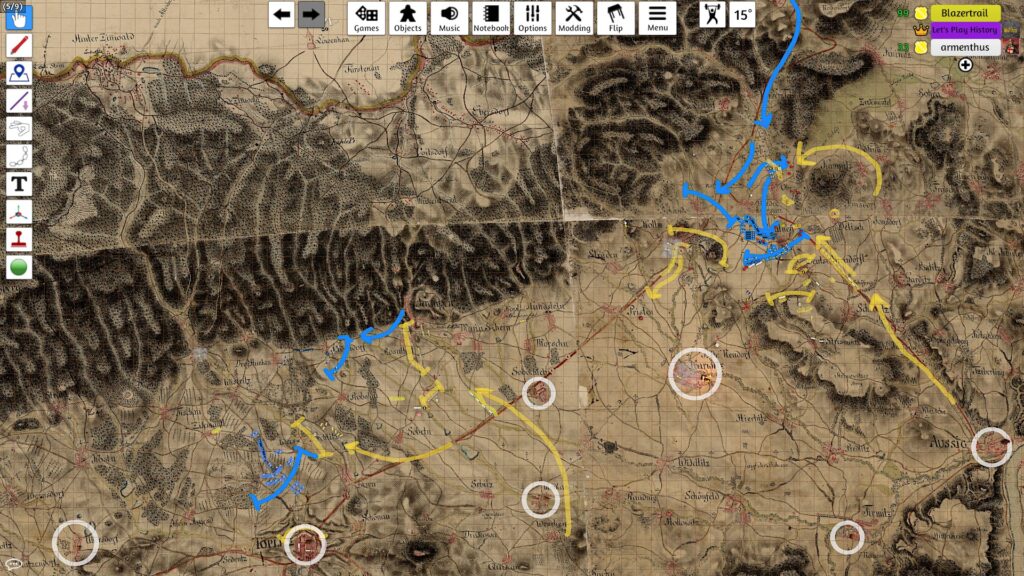Remember when we did Grand Gettysburg back in August 2021? The biggest civilian online live Kriegsspiel run so far, with 34 players and about 50 participants in total. Those who participated remember it fondly, what an experience. You’ll find several recordings under videos.
That was of course not the first game we played on Damon’s beautiful map. We did several test games of Alex’s Brigade System which we used back in the day, and the teams ran drills to prepare for the big event.
Here are some reports of a 3v3 corps-on-corps game we played on 26 June 2021.
This is how Carter experienced the battle.
6/27/1863, Near Gettysburg, PA
Though the events of yesterday are but few hours old, I do believe I shall remember them to my dying day. The smell of powder, of burning grass, and of dead men still fills my nostrils with an awful stench. Permit me, General Meade, if you will, to describe to you the actions at Gettysburg as I witnessed them, that you might understand the trials my boys faced in the heat of the June sun.
As dawn broke, III Corps was positioned north of town, a few hours marching away. We had been warned that a Confederate force, a division, perhaps an entire corps, was bearing down on Gettysburg. I ordered that all preparations be made to march as soon as possible. Not long after, I received word from General Sickles that my division would lead the column into Gettysburg.
As we expected action later in the day, I placed the Gibraltar Brigade at the head of my column. “Anything encountered today would be nothing compared to what these boys had seen before,” I thought. Next in my column and in battle experience was the 1st Brigade. My newest unit, 2nd Brigade, brought up the rear of the column with my two batteries of artillery spaced between the brigades.
We received our orders at 7:00am and began the march south to Gettysburg along the Carlisle Road. As we marched, Custer’s Wolverines rode by us through the fields on either side. I asked Custer what his intentions were and he proudly proclaimed “I intend to find this rebel division and destroy it myself!” I chuckled at his characteristic hubris and waved him on as his men fanned out in front of my column in order to find the enemy.
By 11 O’clock I could see from my position at the head of the column the outlines of the buildings in town. We carried on marching through town, though having switched to the Taneytown Road. This was done at the behest of Sickles, who did not wish for my division to become entangled with that of Humphrey. Humphrey’s men came into town along the York Pike before turning onto the Carlisle Road. The two divisions marched adjacent to each other through the town. My division, upon reaching the Emmitsburg Road, turned and used it as their avenue south of town while Humphrey’s division turned onto the Baltimore Pike.
At around this time, 11:20, I received intelligence that the enemy was likely advancing up the Emmitsburg Road. General Sickles, who was with me, at once hatched a plan. My division was to prepare a defense along the Emmitsburg Road and hold off the enemy, while Humphrey was to advance along the Baltimore Pike before swinging right on the Schoolhouse Road. The idea was to have Humphrey’s men appear in the area of the Peach Orchard, catching the enemy with their backs facing his men, and their fronts receiving the disciplined fire of my boys. Sickles told me the plan before riding off to accompany Humphrey’s division for the flank march. As that was the more complex and volatile of the maneuvers the plan entailed, it was his duty as corps commander to oversee its smooth completion.
As for my division, I began arranging a battle line. I deployed the Gibraltar Brigade on a line facing south between the Taneytown Road at the Leister Farm and the Emmitsburg Road, the 3rd Regiment taking up positions across the road itself. 1st Brigade filed into line on the right, guarding the western side of the approach. I placed one battery of artillery between two regiments of the Gibraltar Brigade on the east side of the road and the other between two regiments of the 1st Brigade on the west. I left my inexperienced 2nd Brigade as a reserve at the Emmanuel and Trostle Farms, as I did not yet know whether my enemy would attempt to flank my position from the left or the right. I suspected that a second enemy division would come up the Taneytown Road, but I was not willing to play all my cards at the outset.
With my forces thus positioned I heard from beyond the Peach Orchard the faint sound of gunfire. As the orchard sits atop a piece of high ground I could not see the source, although I figured it must have been Custer’s brigade.
At this time I received a dispatch from Humphrey: “My division is nearing the School House Road to turn west and form. I’m hearing shots over there; how is your division faring and what are the enemy’s dispositions?”
To which I sent this reply: “My division is just dandy. The enemy is to my front. I do not know their strength. My division is in battle line between the Taneytown and Emmitsburg roads guarding the approaches to town. Will update you when I have made contact.”
The results of the skirmish were soon apparent as Custer’s men appeared over the ridge riding at full gallop toward my lines. His men, retreating but organized, skillfully passed through gaps I had prepared in my lines upon seeing the retreat. Custer himself rode over to me and exclaimed: “You’ve got Pickett’s Division to your front! We encountered their cavalry vanguard, but I could make out the banners of the infantry on the road behind!”
I thanked him for the report and asked him if he saw another division with them. He wasn’t sure, so I asked him to scout out the approaches west of town. He agreed, saluted me, and rejoined his men. While I had not guessed it, my suspicion of enemy movement to the west was not unfounded, yet Custer’s men failed to find the flanking force until the last possible moment. While his actions later in the battle incline me to forgive him, this failure of intelligence would prove costly to my division. That was in the future, however, the time was still 12:20, and as Custer’s men rode away I glimpsed the glinting barrels of Confederate muskets on the horizon.
At this time I sent a dispatch to Humphrey: “Let me know if you encounter McLaws on the Taneytown road. I see Pickett deployed to my front. Cannot see McLaws.”
Pickett’s division was a force to be reckoned with. The Virginians had been fighting on their home soil for the better part of three years by now. Each and every one of them knew the stakes should this invasion of the north be repelled. They displayed their experience as they formed battle lines on the march. Armistead’s brigade, which I could identify by their colors, fanned out to my right, while Kemper’s brigade took up positions opposite the Gibraltar Brigade on my left. I had told my gunners to aim for the artillery if the enemy infantry was too far away to shoot at us, but the advance of Armistead and Kemper was astonishingly swift. My gunners, thinking quickly, abandoned their prior orders and opened fire on the infantry. By 12:40 the Confederates had advanced to within 200 yards and both sides began exchanging volleys.
I saw more enemy units deploying on my left through the smoke. I could not make out from which division they were, but I suspected they were from McLaws’ division. I sent Humphrey another dispatch: “I am fully engaged. Pickett to my front, McLaws is deploying on the Taneytown Road. You are in a good position to attack McLaws from the flank and rear. Please march west and engage them as soon as you can. I will hold while I can. Make a good show of it.”
In the initial exchange my men took the lesser part, suffering heavy casualties. Lines of men melted before my eyes in the hail of fire. However, as the battle continued, and as my cannons began firing canister, the Confederate lines began to waver. My boys kept loading and firing as fast as they could and by 1:00pm the brigades of Armistead and Kemper began to weaken beyond the point of repair. At this time I also received a report from Sickles, who was with Humphrey but had now arrived at my position, that Humphrey’s division was engaged with an enemy force, probably the men of McLaws’ division. At once I seized the opportunity to roll up Pickett’s line and smash into the flank of McLaws, who I presumed to be holding a position along the Taneytown road guarding against Humphrey’s advance up the Schoolhouse Road. I ordered 2nd Brigade, my reserve, to take up position on the far left, and swing down upon Kemper’s flank with a bayonet charge. They did so brilliantly and Pickett’s lines began to fall back in disarray toward the Peach Orchard. In the chaos of the charge and with all the powder smoke I had lost sight of and contact with 2nd Brigade, who in their eagerness I presumed were pressing the attack.
I was about to order the rest of my division forward when I received a report from Sickles, who had been riding back and forth between myself and Humphrey. Sickles announced that it was not McLaws that Humphrey had encountered, rather, it was Garnett’s brigade of Pickett’s division. This sent a chill down my spine. McLaws’ division was still unaccounted for and they were not on my left. Sickles and I knew exactly what that meant. I immediately ordered 1st Brigade and the Gibraltar Brigade to Seminary Ridge in order to guard the western approaches to town. I suspected McLaws was advancing at that very moment down the Hagerstown Road. As if on cue, as my division was redeploying across the field to Seminary Ridge, Custer’s cavalry came sprinting down from the ridge. Custer found me quickly and, out of breath from the heavy riding, shouted: “McLaws’ entire division is coming over that ridge as we speak! Get your men into battle line! Now!”
General Sickles, who was with me, and I bagan hastily assembling an ad-hoc battle line atop a small rise between the Emmitsburg Road and Seminary Ridge. As we did, I glanced up at the ridge to see Barksdale’s Brigade bearing down on our position. Custer wheeled his cavalry around and ordered them to dismount, shouting “come on you wolverines!” They took up the right flank of this new line. The remnants of 1st Brigade formed to their left. The Gibraltar Brigade, badly mauled by Pickett’s division, had been marching up the Emmitsburg Road and was not immediately ready to join the line. One of my artillery batteries had been in the field and deployed between the Custer’s brigade and 1st Brigade. The artillery unlimbered just in time to fire a volley of canister shot into the middle of Barksdale’s line, devastating the regiment Barksdale had placed there. My chief artillery officer reported to me later that he saw a pink mist through the smoke of his guns. Sickles, seeing that all that could be done was being done, wished me luck and left to assess the situation of Humphrey’s division.
He left just in the nick of time, for a few seconds later Barksdale’s brigade disappeared behind a wall of white powder smoke as their volley tore through my lines. I rode up and down the lines, shouting “hold fast! Hold fast!” My men certainly did, and Custer’s too, keeping Barksdale’s men at bay and withering the enemy’s numbers as Pickett had mine earlier in the day. My only hope was that Humphrey, with Sickles’ help, could finish off Pickett and slam into McLaws’ flank before my line collapsed. As I was shouting encouragements to Custer’s men on the right flank I saw the fresh brigade of Raphael Semmes bearing down in a flanking attack. As I rode back toward the center I saw that Barksdale’s brigade had skillfully been replaced in the line by Kershaw’s brigade so Barsdale’s men could recover from the battering they had received from my men. However, with two fresh brigades crashing against my weakened line I knew I could not hold any longer.
At this time I received a dispatch from Humphrey: “I am finishing off Picket and I will move my whole division onto the flank as soon as possible! Don’t hesitate to give ground, it may work in our favor to draw them in closer so we can attack at two different angles.”
It took scarcely a moment of thought to deduce his plan, and I sent this reply: “I shall begin a withdrawal to Cemetery Ridge. If you attack up the Emmitsburg road you will have their flank.”
At once I ordered a general withdrawal. I told the brigade commanders to fall back to Cemetery Ridge and form a line there along the Emmitsburg Road as best they could. The situation was too confused to assign particular units to sections of the line. I just hoped this retreat would not turn into a rout. My men retreated in good order, firing as they moved, back to the road. My artillery managed to take up a good position atop the ridge with the ability to fire over the heads of my men at the entire Confederate line. Kershaw and Semmes’ brigades slowed in their attack, I presume to reorganize, giving my men ample time to take up orderly positions on this new line.
I received a dispatch from General Humphrey: “I have completely pushed Pickett’s Division back but I have taken casualties and two of my 3 brigades are recovering from heavy fighting. I am redeploying my fresh brigade to move up the Emmitsburg road post haste. They should be there within the hour.”
I sent this reply: “I have fallen back to Cemetery Ridge making my frontline along the Emmitsburg Road from the intersection with the Taneytown Road extending south. Barksdale’s brigade has been badly mauled by my boys and is no longer in the fight. Semmes’ and Kershaw’s brigades have beaten me up but it seems the attack is losing its momentum. If you strike now it may well turn the tide. Do not be hasty, though, it seems my line shall hold for now.”
All I had to do now was hold my ground. I felt the critical moment had come, but I had no say in its outcome anymore. All I could do had been done. It was up to Humphrey now. A few minutes later the attack resumed with full force against my line. The strong but weakened brigades of Kershaw and Semmes slammed against this new line, but, miraculously, it held.
Elated, I sent another dispatch to Humphrey: “Line is holding. The Confederate attack is losing momentum. If you can hook around my left it may well be able to put McLaws in one hell of a crossfire. I shall continue to deal out as much death as I have taken.”
My comfort in seeing this was soon curtailed when I saw, through the smoke, Barksdale’s brigade advancing around my left flank. I had no reserves. My last reserve I had committed to guard the artillery against a brigade of Confederate cavalry which was threatening my right flank. My only hope was that Humphrey would soon arrive, and that he did, when through the smoke on my left I saw the Excelsior Brigade, a new addition to his division, begin a bayonet charge against Barkesdale’s experienced troops. The men of that brigade all deserve medals, for they suffered astonishing losses in the charge. They reinforced my left flank just in time, and in doing so made Sickles’ corps whole again, as now we had one continuous battle line.
The fighting continued for another hour as the men of McLaws’ division bravely but vainly attempted to break my line. Soon I received word that Pickett, after what I’m told was a hard fought engagement, had disengaged and left the field. Before Humphrey could take advantage of this victory to hook around and crush McLaws, McLaws also disengaged. While I wished to pursue them, the state of my division after the battle would not allow it. I retired to a nearby farmhouse which my staff had arranged to be my headquarters for much needed sleep.
I hope, General Meade, that you forgive the absence of my division for a while. I have taken over sixty percent casualties and it will take some time for my command to recover. It is up to you now to finish off the rest of Lee’s army.
Respectfully,
General Birney
On site video after action report
Join our Discord server and become part of a growing community of over 750 members from all around the globe.
Get in touch either on Discord or via e-mail, leave us some feedback or suggestions or ask us anything about Kriegsspiel.
The IKS is commited to ensure inclusiveness and diversity within the community and stands against discrimination and harassment.





